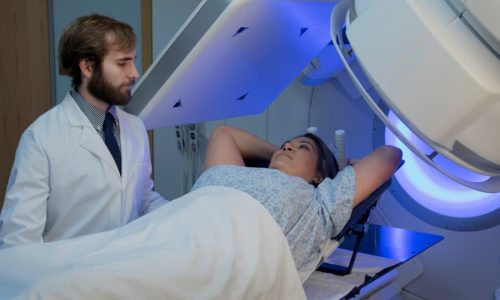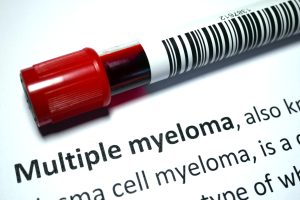
24 RCCA Physicians Named to 2025 Castle Connolly ‘Top Doctors’ List for Exceptional Cancer Care
A cancer diagnosis can be frightening. An individual may worry about how, or if, they will get better. The future becomes unclear and the strain
HIPAA Alert: Potential Data Breach Learn More
Questions on Oncology, Hematology and/or Infusion Clinical Services due to COVID-19 Crisis – CALL 833-698-1623
Important Information for Our Patients Regarding the Coronavirus.
RCCA Providing Area Cancer Patients with Access to Care During Coronavirus Outbreak
RCCA Offering Patients Virtual Visits During Coronavirus Pandemic
Breast cancer is the second most common cancer affecting women in the United States, with only skin cancer occurring more often. Patients with breast cancer have a variety of treatment options, depending on the stage and type of their cancer, with radiation therapy being a widely used approach. Regional Cancer Care Associates (RCCA) provides comprehensive cancer treatment, for patients in New Jersey, Connecticut, Maryland, and the Washington, D.C., area. Here, RCCA shares information about how radiation therapy for breast cancer works and which patients may benefit from it.

Radiation therapy is a cancer treatment that utilizes high-energy beams or particles to damage or kill cancer cells and slow their growth. In the great majority of cases, the radiation is delivered in a highly precise manner, which means that it focuses in pinpoint fashion on the affected area and not the whole body. Far less often, patients may have total body irradiation (TBI) to kill abnormal cells that may have not been killed by chemotherapy or removed during surgery. The goal of TBI is to kill those cells wherever they may be in the body to prevent cancer from coming back. Again, however, narrowly focused radiation therapy is much more common, and is used to treat less-advanced stages of cancer and to relieve cancer symptoms and side effects in more advanced stages.
Radiation therapy (sometimes referred to as radiotherapy) is an effective treatment for many kinds of cancer, including breast cancer, cervical cancer, prostate cancer, and others. More than 50% of patients with cancer will have some type of radiation treatment. It can be used on its own but is often administered before or after other cancer treatments, such as surgery and chemotherapy, to provide the best results.
Breast cancer develops when abnormal cells in the breast grow uncontrollably. There are many types of breast cancer, with the type based on where the cancerous cells first formed in the breast. Most breast cancers originate in the ducts or lobules. The ducts are thin tubes that carry milk to the nipple. The lobules are glandular sacs that produce the milk. Breast cancer can spread (metastasize) to other parts of the body, such as the lymph nodes, blood vessels, and other organs. Women are much more likely than men to be affected by breast cancer, but about 2,800 men in the United States are diagnosed with the cancer each year.
One of the common early symptoms of breast cancer is a hard lump felt in the breast or underarm. Other signs include changes in the size and shape of the breast or nipple, lasting breast pain, swelling, discoloration, and more. However, it’s important to know that not all lumps are cancerous and that other symptoms can be caused by hormonal changes, menopause, and other conditions. To be safe, women who are at average risk for breast cancer should have regular mammogram screenings starting at age 40. Women who may be at elevated risk due to a family history of breast cancer or other factors should talk with their physician about the best age to start receiving mammograms – and all women should talk with their healthcare provider promptly if they notice any unusual changes in their breasts.
When a patient is diagnosed with breast cancer, her cancer will be categorized into one of five stages. The stage of breast cancer is determined by the size of the tumor and whether it has metastasized to other areas. The lower the stage number, the less the cancer has spread and, typically, the easier it is to treat. The breast cancer stages are:
Stage 0 breast cancer, also called noninvasive cancer, is the least advanced form of breast cancer. At this stage, cancerous cells have started to form in the ducts or lobules of the breast but have not spread to surrounding tissues. The most common kind of stage 0 breast cancer is called ductal carcinoma in situ (DCIS). Surgery is the treatment approach used most often for stage 0 breast cancer.
Stage I breast cancer is considered invasive breast cancer. There are two types of stage I breast cancer:
In Stage II, the tumor is relatively large and may have spread to nearby lymph nodes. The two types of stage II cancer are stage IIA and stage IIB.
Treatment options for stage II breast cancer include surgery, radiation therapy, or a combination of the two.
Stage III breast cancer is invasive breast cancer in which the tumor continues to grow and spread. The tumor can be as large as 2 inches and can metastasize to surrounding lymph nodes and other tissues. There are three types of stage III breast cancer:
Treatments for stage III breast cancer include chemotherapy, radiation therapy, hormone therapy, surgery, and targeted therapy. These treatments are often used in combination for the best effect.
Stage IV breast cancer, or metastatic breast cancer, is the most advanced form of the disease. The cancer is not confined to the breast any longer and has spread to distant areas of the body, such as the bones, lungs, brain, or liver. There is no cure for metastatic breast cancer. However, recent years have seen a dramatic expansion of treatment options for Stage IV breast cancer that have greatly prolonged people’s lives while enabling them to maintain quality of life. These treatments include immunotherapies, targeted therapies, and new approaches to radiotherapy.
Determining the stage of a patient’s breast cancer enables medical oncologists to choose the most appropriate treatment strategy. Most patients with stage I, II, or III breast cancer are treated first with surgery to remove the tumor, usually followed by radiation therapy to kill any remaining cancer cells.
As noted above, radiation therapy is one of the most common treatments used to manage breast cancer. It is often administered after the patient has surgery to remove a tumor. Radiation helps destroy any remaining cancer cells. This decreases the chances of the cancer recurring. Radiation can also be given when breast cancer has spread to other areas of the body to help relieve side effects and symptoms.
If patients would benefit from radiation therapy after surgery, she usually needs to wait until the surgical site is fully healed. Patients who need radiation and who are also candidates for chemotherapy usually will receive their radiation once the chemotherapy regimen is completed. Other breast cancer treatments, such as hormone therapy and targeted therapy, can be given simultaneously with radiation therapy.
There are two main types of radiation therapy used to treat breast cancer: external beam radiation therapy and internal radiation therapy. The type used will depend on the stage and subtype of the patient’s cancer, as well as factors such as the patient’s overall health.
External beam radiation therapy (EBRT) is the type used most often for breast cancer treatment. A highly sophisticated machine called a linear accelerator directs precisely targeted high-energy rays directly into the affected areas of the body to damage the DNA of cancer cells, causing those cells to die and stopping the cancer from spreading.
Internal radiation therapy is used in some cases of advanced breast cancer. In one form of internal radiation therapy, a minimally invasive procedure is performed to place a radioactive substance inside the patient’s body. The substance is placed near the cancer to kill cancerous cells. In another approach, when metastatic breast cancer has spread to the bones, a radioactive substance can be injected into a vein. It then circulates through the body for a limited time, killing cancer cells in the bones and relieving bone pain.
When a patient with breast cancer is prescribed radiation therapy, it is usually external radiation. EBRT is administered at an outpatient center or hospital where the patient will:
The radiotherapist may take scans or make marks on the affected area to ensure the positioning is correct. Then, the therapist will move the machine into place and leave the room to turn it on. The radiation is then delivered. This only takes a few minutes. However, the whole process can take up to an hour with paperwork and scans. The patient is monitored throughout the treatment to make sure she is comfortable and safe.
How long does radiation therapy take to complete?
The length of radiation therapy treatment is different for each patient, but it is usually given in a course of treatments over three to six weeks. The treatment sessions themselves only last between a half hour and an hour, but they may need to be done each weekday or a few days each week.
How do patients know if radiation therapy is working?
Once a patient finishes her course of radiation therapy, the medical team will schedule follow-up imaging tests to see if the tumor has shrunk. Other assessments also may be made.
Does radiation therapy for breast cancer cause side effects?
Radiation therapy can cause side effects because both the cancerous and non-cancerous cells in the treated area are affected by the radiation. The non-cancerous cells typically return to normal over time, but there can be side effects in the meantime. Common side effects of radiation therapy in patients with breast cancer include fatigue and skin irritation, discoloration, and peeling.
Does radiation therapy for breast cancer lead to any long-term effects?
Radiation therapy to the breast and armpit area can lead to some side effects that may not appear until weeks, months, or even years later. Some women may not be able to breastfeed from the breast that received radiation treatment. Other women may have issues with nerve damage or lymphedema (lymph node swelling) in the armpit. Radiation therapy can also impact a woman’s options for breast reconstruction down the road or lead to changes in appearance in previously reconstructed breasts.
Patients with breast cancer can receive comprehensive care at RCCA, one of the nation’s largest networks of oncology specialists. RCCA’s medical oncologists and hematologists provide world-class care close to home. They offer the latest medical therapies for breast cancer and collaborate closely with a patient’s primary care provider, radiation oncologist, and other physicians to ensure that each patient receives highly individualized, compassionate care. Patients throughout New Jersey, Connecticut, Maryland, and the Washington, D.C., area can receive care at more than 20 RCCA locations. To learn more about breast cancer treatment at RCCA, request an appointment today.
For more information or to schedule an appointment,
call 844-346-7222. You can also schedule an appointment by calling the RCCA location nearest you.

A cancer diagnosis can be frightening. An individual may worry about how, or if, they will get better. The future becomes unclear and the strain

Multiple myeloma (MM) is a rare type of blood cancer that often develops without early symptoms, making awareness of risk factors essential. Regional Cancer Care

A cancer diagnosis can bring a wide range of emotions, from fear and stress to sadness and hope. These feelings are a natural part of

Regional Cancer Care Associates is one of fewer than 200 medical practices in the country selected to participate in the Oncology Care Model (OCM); a recent Medicare initiative aimed at improving care coordination and access to and quality of care for Medicare beneficiaries undergoing chemotherapy treatment.